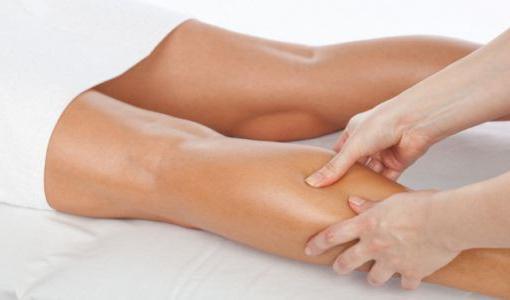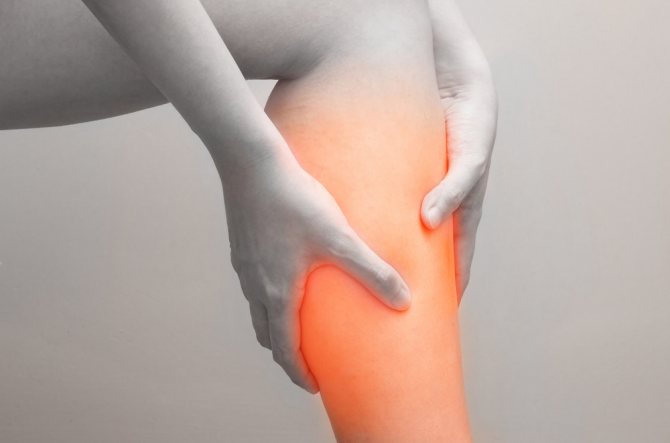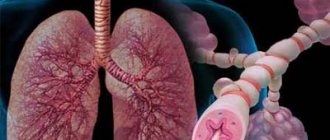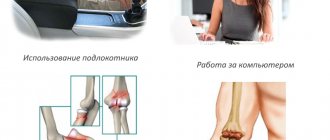Crampy syndrome is a sharp and very painful tonic contraction of a muscle, part or several muscles, which can be provoked by several factors simultaneously.
Research shows that almost half of the world's population suffers from this syndrome from time to time. However, it often manifests itself in completely healthy people. In some, Crampy syndrome develops against the background of regular and generalized fasciculations (shortening of one or more motor units).
Why does a cramp occur?
The causes are physiological (primary) and pathological (secondary). Relatively safe physiological causes are muscle strain, as well as temporary metabolic disorders.
In a healthy person, muscle cramps are provoked by the following factors:
- unusual long-term, high-intensity exercise;
- non-physiological muscle tension caused by diseases of the spine and joints of the limbs;
- alcohol abuse;
- insufficient sleep;
- smoking;
- violation of the temperature regime - overheating or hypothermia;
- water and electrolyte disturbances (excessive sweating in the heat, insufficient fluid intake, use of diuretics and medications);
Pathological causes of crampy are various diseases and conditions of the organs and nervous system. These include:
- diseases of peripheral nerves – radiculo- and polyneuropathy;
- Parkinson's disease;
- diseases of the central nervous system - spinal amyotrophy, amyotrophic lateral sclerosis, consequences of poliomyelitis;
- multiple sclerosis;
- liver diseases, especially chronic hepatitis and cirrhosis;
- intestinal diseases, especially viral enteritis;
- kidney disease, especially chronic renal failure with uremia;
- muscle diseases – muscular dystrophies, metabolic myopathies;
- endocrine diseases - diabetes mellitus, hypothyroidism, decreased function of the parathyroid glands;
- growth and development of tumors, benign and malignant;
- iron deficiency in the body;
- obliterating diseases of the vessels of the lower extremities;
- heart failure accompanied by edema;
- pregnancy.
Cramps can develop after blood purification operations - hemodialysis and plasmapheresis. In some cases, the cause of convulsive contractions cannot be detected; such conditions are called idiopathic.
There are familial forms when cramps occur in adolescence or old age for no apparent reason. Such forms have a wave-like course and spread to the muscles of the thighs and anterior abdominal wall. A spasm of the mylohyoid muscle is characteristic when, after yawning, its unilateral contraction develops. Researchers believe that the mechanism of hereditary transmission of this form is autosomal dominant. Many people associate cramps with a deficiency of vitamins B and D, as well as electrolytes.
Leg Cramps and Magnesium
Although cramps can be a simple manifestation of metabolic disorders in the muscle, for example, with chronic magnesium deficiency.
This is probably a very common reason . Magnesium is a unique mineral; it takes part in hundreds of biochemical processes in the body (according to modern ideas, about 300 biochemical processes in the human body occur with the participation of magnesium). This element is needed everywhere, and comes with food in insufficient quantities, since we eat foods rich in magnesium in small quantities (bran, nuts, pumpkin seeds, sesame). But magnesium is consumed intensively during stressful conditions (used by the nervous system), during heavy physical activity and in the heat (excreted in sweat), when drinking large amounts of liquid (excreted in the urine) and with frequent intake of alcoholic beverages. And if a muscle lacks magnesium, it becomes more prone to tension and spasms. For the same reason (magnesium deficiency), the eyelid may “twitch” - the orbicularis oculi muscle is tender and very sensitive to a lack of magnesium.
I was recently asked if there was an alternative to supplementing with magnesium other than using Magne B6. There are other preparations containing magnesium: Magnerot, Magnicum. It is believed that magnesium is well absorbed from the intestines in the presence of pyridoxine (vitamin B6) or in the form of an orotic acid salt, but in food products magnesium often comes with calcium or phosphorus, and they prevent magnesium from being absorbed in the intestines. When cooking products, its amount decreases significantly. And food products contain less and less of it due to the rapid development of “new technologies”. You can, of course, provide yourself with magnesium through proper nutrition, but you really have to want it.
Diagnostic principles
Only a doctor can distinguish a physiological reaction from a pathological condition; it is impossible to do this on your own.
You should not worry only if cramps occur rarely, no more than once a month, and the cause “lies on the surface”, there is a clear connection with physical overload, profuse sweating or other “natural” reasons mentioned above. In all other cases, you need to see a doctor as early as possible to rule out diseases or adjust your medication intake. Particularly noteworthy are long, protracted convulsive contractions that are repeated.
Sometimes muscle tightness and soreness last for several days. An indirect confirmation of long-term cramps is an increase in the level of creatine phosphokinase. Tonic spasm of the muscles of the chest or diaphragm is rare, but can create a picture of a heart or lung infarction.
Careful diagnosis is the basis for successful treatment. Due to the variety of reasons, the examination may take about a week. The diagnostic equipment of the CELT clinic allows us to identify hidden diseases that a person did not know about. An important aspect is the determination of homeostasis indicators and their possible deviations from the norm. The identified changes in water-electrolyte metabolism make it possible to quickly correct the condition.
A set of diagnostic procedures may include, if necessary, not only general clinical tests, but also electroneuromyography, studies of the function of the heart, thyroid gland, kidneys and other organs. ENMG outside an attack can reveal signs of primary muscle pathology and disruption of muscle innervation; high-frequency and amplitude potentials are recorded during muscle contraction.
It is known that cramps occur more often in people with “thick” calves or some hypertrophy of these muscles. Researchers attribute this to the large amount of myoglobin in them (the so-called “red muscles”). It is interesting that among peoples who spend a lot of time squatting and thus constantly straining their calf muscles, cramps are observed much less frequently. However, prolonged stay in this position can lead to pinching of the peroneal nerve.
How to get rid of painful cramps
Crampy syndrome, the treatment of which is aimed at restoring the functioning of muscles that act as antagonists of spasm, is not considered a pathology. This phenomenon is most likely a feature of the tissues of the human body.
When a painful cramp appears, you should pull your foot upward with all your might, while keeping your knee straight. In this way, it will be possible to stretch a muscle that is seized by a sudden spasm. With this technique you can get rid of severe pain. Some people with crampy syndrome are helped by pressing their feet firmly on the floor surface. But the first method is considered more effective.
You can eliminate involuntary muscle contractions using other methods:
- walking on your heels for 2-3 minutes;
- a hot foot bath or shower, the duration of warming the affected muscle should be at least 5 minutes;
- walking with high legs;
- massage using ice cubes.

Treatment rules
Crumpies themselves do not pose a threat to life or health. However, they are extremely painful and cause a lot of trouble. The symptoms accompanying cramps are varied, so the efforts of the doctors at the CELT clinic are aimed at identifying the underlying disease. Treatment of this disease, as well as the abolition of excess medications, can quickly improve health outcomes.
Emergency relief for pain relief consists of passive stretching of the contracted muscle or voluntary active contraction of the antagonist muscle. So, when there is a cramp in the calf muscle, you need to stand up, leaning on the irritated leg, and when the muscles of the fingers contract, straighten them with your hand.
To prevent cramps after physical activity, you need to raise your legs high from a lying position. In this position, venous outflow improves and the likelihood of convulsive contraction decreases. If electrolytes are lost through sweat or diarrhea, potassium and magnesium supplements are recommended.
Physiotherapy is used as an auxiliary method, in particular the following methods:
- physical therapy aimed at general strengthening of muscles;
- contrast water procedures, massage and hardware types of physiotherapy.
If the effect of physiotherapeutic procedures is insignificant, the doctor may prescribe medication.
Clinical picture
Crumpy usually affects the distal parts of the legs or, in other words, their lower parts. It has been noticed that the calf muscles most often suffer from cramps.
However, if a person has certain neurological diseases, convulsive conditions can occur in the facial and neck muscles, and intercostal muscles. Plus, the thighs and arms can cramp.
Crumpy occurs suddenly, the person does not feel any warning symptoms. Typically the syndrome is unilateral (meaning it affects only one leg).
In addition, studies show that in most cases, cramps are caused by “red muscles, that is, those in which the level of myoglobin is high, in which phosphorylases have low activity, and oxidative enzymes have high activity. “White” muscles have slightly different properties.
Crumpy is not characterized by any confusion or loss of consciousness, however, very severe pain is noted at the site of the spasm. And when palpated, you can detect a small compaction. In addition, even with the naked eye, deformation of the muscles can be noticeable or their contours simply appear more clearly than usual.
Convulsions in the syndrome are tonic in nature. This means that with this syndrome, twitching of the muscle or its individual segments is not noticeable.
Prevention
Giving up bad habits, streamlining your lifestyle and nutrition are the basic principles of prevention. Along with this, moderate physical activity is useful - walking or exercising on an exercise bike. It’s good to do simple muscle stretching exercises in your free time. At any time of the year you need to drink a sufficient amount of clean water - 30 ml per kilogram of weight in the cool season and 50 ml in the hot season.
For those who experience frequent cramps, it is advisable to reduce the consumption of drinks containing a lot of caffeine and stop smoking. When sleeping, you need to cover yourself warmly, especially keep your feet warm.
The best prevention of cramps, as well as other disorders, is an examination that can be completed at the CELT multidisciplinary clinic at any time.
Make an appointment through the application or by calling +7 +7 We work every day:
- Monday—Friday: 8.00—20.00
- Saturday: 8.00–18.00
- Sunday is a day off
The nearest metro and MCC stations to the clinic:
- Highway of Enthusiasts or Perovo
- Partisan
- Enthusiast Highway
Driving directions
Set of measures
In order for the spasm to stop, doctors advise to massage the muscle with which the spasm occurred. The essence of the massage is to make the antagonist muscles work. By “turning on” they will stop the spasm.
If a cramp occurs while lying on the bed, you should get up and walk on the cold floor for a few minutes.
It is also recommended to eliminate provoking factors. For example, if it is noticed that a cramp occurs after certain exercises in the gym, then it is better to completely eliminate such exercises.
To relieve and reduce cramps, among other things, therapeutic exercises, contrast showers, and so-called physiotherapy are used.

As mentioned above, crampy is a sign of many neurological diseases, including such serious ones as amyotrophic lateral sclerosis. With this disease, the motor neuron is affected and it is unlikely that it will be possible to stop seizures using the methods listed above.
Here you need quite powerful medications - Baclofen, Diazepam, etc. Of course, they can only be taken strictly as prescribed by a neurologist.
Let's take another similar example. Cramps become a common occurrence with complications of lumbar osteochondrosis. Consequently, all the methods and medicines that are traditionally used in the fight against this very osteochondrosis become good.
...and for women
In women, the cause of cramps is often varicose veins. The severity of the disease is aggravated by age, pregnancy, sedentary work, and high-heeled shoes.
Cramps with venous insufficiency occur at rest, after a hard day “on your feet” or prolonged sitting on a chair. First there is a feeling of crawling, tingling, numbness, which is replaced by bursting, aching pain. The muscles are contoured (tightened) weakly.
Cramps due to venous insufficiency are well relieved by massage of the calf muscles. The onset of an attack can be stopped by squatting. Before going to bed, it is useful to do contrasting water douses of the legs up to the middle of the thigh, paying special attention to the inside of the lower leg and knee joint. Women with varicose veins are recommended to wear compression stockings, do leg exercises daily, and take courses of vascular medications (venotonics).
First aid for crumpy
The reasons for this phenomenon are very diverse.
Muscle cramps are unpredictable and appear at any time of the day. They can accompany existing pathologies or be a consequence of past diseases. In addition, spasms can also bother healthy people. A certain difficulty is caused by the fact that crampy syndrome is a condition in which it is difficult to identify the main factor that served as the impetus for its appearance. In most cases, a comprehensive examination of the body is required.
https://www.youtube.com/watch?v=u2bEfZG-aOY{amp}amp;t=9s
Possible causes of cramps (symptoms, diagnosis and therapy for each of them may differ) are as follows:
- In healthy people, an irrational approach to physical activity, dehydration due to excessive sweating or diarrhea. In addition, muscle cramps can be random in nature; they are called idiopathic. The reason for their appearance is still unknown. During a spasm, the foot may be briefly fixed in an unusual position.
- Neurological diseases associated mainly with damage to the cells of the anterior horns of the spinal cord. In addition, cramp syndrome can be a consequence of polio, malignant neoplasms, trauma, hyperactivity, muscular dystrophy, rigid person and Satoyoshi syndromes.
- Metabolic disease. As a rule, it occurs during pregnancy, excessive excitability of muscle tissue and the nervous system (tetany), and malfunction of the thyroid gland.
- Taking certain medications, for example: diuretics, corticosteroids, drugs containing lithium and salbutamol.
- Excess vitamin E in the body.
- Cirrhosis of the liver.
- Surgical manipulations on the organs of the digestive system.
- Poisoning with pesticides, salts of heavy metals.
- Toxic substances that enter the body as a result of the bites of certain insects.
As soon as the spasm has made itself felt, the following actions will help relieve it as soon as possible:
- you need to try to take several steps;
- pinch the skin several times in the tense area;
- sitting, straighten your leg and pull your toe towards you;
- Using rubbing movements, massage the painful area from bottom to top.
After the cramp disappears, you can use a warming ointment.
How do crampies appear?

Most often, cramps occur in the distal parts of the lower extremities. But in some neurological diseases they can be observed in the intercostal, cervical and facial muscles, in the thigh and arm.
Muscle spasms during cramps are local, usually one-sided, and develop suddenly and without warning. Although, if increased physical activity is a provoking factor, a feeling of muscle fatigue may be noted. Such convulsions are not characterized by confusion or loss of consciousness.
Crumpy is tonic in nature, that is, it is not accompanied by twitching of the muscle itself or its individual fibers. But in some diseases, concomitant fasciculations may appear at the beginning and end of crampial cramps, involving the same area. Less common are background generalized fascicular twitches in different muscle groups. A combination of tonic and local clonic convulsions occurs in ALS, some hereditary diseases with muscle pathology, and paraneoplastic syndrome.
With cramps, intense, sudden pain occurs at the site of the spasm. When palpated, a painful, dense ridge is noted here; deformation and excessive contouring of the muscle are often visible.
With cramping, a forced position of the part of the body involved in the process appears. Tonic contraction of the gastrocnemius muscle causes hyperextension of the leg at the ankle joint, which is accompanied by secondary spasm of the arch and toe flexor muscles. If the cramp occurs in the intercostal muscles, inspiratory volume may temporarily decrease. Sudden severe chest pain can mimic acute diseases of the respiratory and cardiovascular systems.
After relief of an acute spasm, local aching pain and a feeling of muscle fatigue may persist for some time.
What causes crumpy to appear?

In addition to increased repetitive stress on certain muscle groups, existing disorders of the blood supply and innervation predispose to the development of muscle spasms. Therefore, people with obliterating atherosclerosis of the lower extremities, peripheral edema of various origins, smokers and alcohol drinkers, pregnant women with lymphatic and venous stasis in the legs are at risk for cramps.
Prolonged forced positioning of the body during pain and muscle-tonic syndrome, uneven load on the limbs lead to muscle exhaustion and contribute to the development of spasms. Therefore, people with spinal diseases, as well as those who have recently suffered injuries to the back and lower extremities, often complain about cramps.
In the presence of predisposing factors and diseases, seizures can occur not only during physical activity. They can be triggered by passive muscle stretching, stretching, turning over in sleep, or hypothermia.
Reasons for development
Several reasons always contribute to the formation of crampy syndrome. It can be a form of the body’s reaction to external stimuli, an independent disease, or one of the signs of certain somatic disorders. In medicine, the following factors have been identified that cause the development of painful spasms:
- Idiopathic. The occurrence of convulsive attacks does not have a specific cause. Occur from 1 time per day to 3 episodes per week, regardless of physical activity, even in a quiet position. Idiopathic cramps can be hereditary in nature - and their extreme stability is noted.
- Physical. Skeletal muscles can normally react by contracting to high or low temperatures, dehydration, physical exhaustion of the body, significant stress, and a large amount of salt in the diet.
- Somatic. Crampy syndrome is part of a symptom complex in liver cirrhosis and renal failure. Hormonal disorders, water-electrolyte imbalance in endocrine diseases also contribute to the development of convulsive attacks. Quite rarely, the crampi mechanism is triggered by paraneoplastic syndrome, glycogenosis.
- Medication. Involuntary seizures can be caused by an overdose or a side effect of certain medications. This most often occurs with the use of diuretics, statins, calcium channel blockers, and β-blockers. Acetylcholinesterase inhibitors and steroid hormones cause convulsive reactions less frequently. Cramps can result from treatment with antibiotics, psychotropic, and nootropic drugs.
- Neurological. Muscle spasms may indicate the development of Parkinson's syndrome, multiple sclerosis, atrophic lateral sclerosis, Charcot-Marie-Tooth disease and other diseases accompanied by high muscle tone and involuntary muscle activity. Injuries to nerve fibers, spinal nerve roots, osteochondrosis, poly-, mononeuropathy can also trigger the onset of the disease.
REASON #4: taking medications
Some medications can also provoke the development of cramps. These are diuretics (diuretics), vincristine (prescribed for tumors and blood diseases), salbutamol (used for lung diseases, often as part of inhalers), nifedipine (taken for arterial hypertension and heart disease), drugs that lower blood cholesterol levels (drugs from atherosclerosis), interferons (drugs that affect immunity), etc.
Constantly recurring seizures while taking these medications is a reason to consult a doctor. In this case, the drug is usually discontinued or the dose reduced. Or they prescribe additional drugs that relieve side effects.








